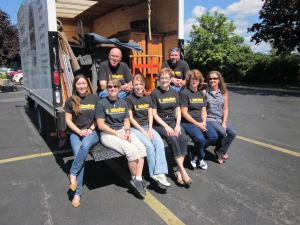By Rachel Kerstetter, PR Engineer
Pictures are incredibly powerful marketing, PR and social media tools. Every single project that I work on for Sonnhalter’s clients involves some form of visual element… which is also one of my biggest challenges as a public relations professional.
Trying to wrangle high-resolution images for a project is tough because sometimes the photo well is just not deep. In our digital age, it doesn’t make sense to not have photographs of basically everything. There is no concern regarding wasted film because everything is digital.
Here are my tips on making sure you have an ample supply of good photos to accompany your marketing communications programs:
1. Think that everything your company does is photo-worthy.
If you host or attend an event, you should take pictures. That includes: Trade shows, customer events, employee events, seminars, etc. [Tweet This]
2. Take a lot of photos.
Not all pictures will turn out great, some will be blurry, someone will have their eyes closed or being making a horrible face. Take several pictures to make sure that you have useable ones. For example, for last year’s Sonnhalter Tool Drive, we took 50 photos and a couple of videos and only used 13 of them in our Facebook album from the event.
For events and trade shows, don’t limit your photos to just the pre-event set up. Capture some action, get people in your photos, both candid and posed. After events, people love to go back and see if they were caught on camera.
3. Assign someone to take photos.
Chances are there is someone in your organization who is pretty good at taking photos. Find that person and leverage their abilities. If you aren’t sure, ask for a volunteer to run around and capture photos. They don’t have to be a professional or even use a DLSR camera (although those will yield higher quality photos). It’s also okay to duplicate photos, so having more than one person taking pictures is fine.
4. Equipment doesn’t have to be complex.
For any photo or video needs, you don’t need professional-grade equipment to capture events. (If you’re putting together something like a commercial or instructional video, that’s a different story, and you should definitely engage a professional). For catching your company picnic three-legged race, an iPhone will do fine. Want some candids from a trade show? These days, most smartphones can yield high-resolution images or bring along a “point-and-shoot” digital camera.
5. Get high-resolution.
When I’m writing something for a print publication, high resolution images are often the biggest challenge. The standard for an image being “hi-res” is 300dpi (dots-per-inch) or greater. That means when supplying photos to your marketing team, agency or an editor, do not just click download from Facebook. Send them the original(s), even if you have to use a file transfer or sharing service such as DropBox or HighTail (formerly You Send It).
6. Use the photos you take.
Upload photos to your company’s social media accounts, provide them to your agency or editors for stories, share them with your staff on your intranet, etc.
Here are some general tips for getting good photos and videos:
- Keep your finger off the lens (also remove smudges)
- Don’t use the front-facing camera on a mobile device, these cameras typically take lower quality photos
- Take at least three photos for one group or individual pose
- Avoid shooting photo/video through windows or screens if possible
- Hold smartphones horizontally or in “landscape” to video instead of vertically, it provides a much better viewing experience later
- Be courteous to those around you when photographing for example, turn off flash for performances and speeches, and be extremely mindful if you must take pictures using an iPad or tablet as most who photograph with them block others’ views and are more disruptive (I highly recommend that you use a smartphone or camera and not a tablet)
- Try to avoid photographing/videoing people at an upward angle (it is unflattering to the subject) or with light behind them (try to have the main light source behind you and not the subject)

